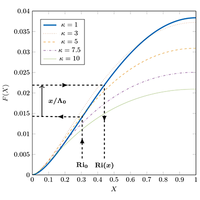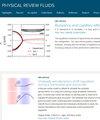Analytical solutions for long-time steady state Boussinesq gravity currents flowing along a horizontal boundary of finite length
IF 2.5
3区 物理与天体物理
Q2 PHYSICS, FLUIDS & PLASMAS
引用次数: 0
Abstract
This paper presents analytical solutions for a steady turbulent miscible gravity current flowing along a horizontal rigid boundary of finite length into a quiescent uniform environment. These solutions are obtained from the governing equations (mass, momentum, and buoyancy) originally proposed by Ellison and Turner [J. Fluid Mech. 6, 423 (1959)] for a buoyant layer of fluid in the Boussinesq approximation. For a constant drag coefficient and the specific entrainment law being the local Richardson number, we first derived a system of coupled ordinary differential equations describing the longitudinal evolution of the velocity , the height , the density deficit , and the Richardson number of the current. For an initially supercritical flow , explicit relations are found for and solely as a function of the Richardson number . The longitudinal evolution of the Richardson number is then theoretically obtained from a universal function which can be tabulated and, as in the present paper, also plotted. The function allows us to determine (and only from the knowledge of the boundary conditions at the source) whether the flow remains supercritical over the whole length of the rigid boundary, or might transit towards a subcritical state (). In this latter case, the mathematical resolution is modified by including a discontinuity similar to a hydraulic jump. The location and amplitude of this discontinuity are calculated from an additional universal function and the injection conditions. The method is finally extended to provide analytical solutions for other classical entrainment laws.

沿有限长度水平边界流动的长时间稳态布辛斯重力流的解析解
本文提出了沿有限长度水平刚性边界流向静态均匀环境的稳定湍流混杂重力流的解析解。这些解法来自 Ellison 和 Turner [J. Fluid Mech. 6, 423 (1959)]最初提出的布森斯克近似浮力层流体的控制方程(质量、动量和浮力)。对于恒定的阻力系数 Cd 和特定的夹带定律 E∝Ri-1(Ri 是当地的理查德森数),我们首先导出了一个耦合常微分方程系统,描述了水流的速度 u、高度 h、密度亏损 η 和理查德森数 Ri 的纵向演变。对于初始超临界流(Ri0<1),可以发现 u(x)、h(x) 和 η(x) 完全是理查森数 Ri(x) 的函数。理查德森数的纵向演化可以通过一个通用函数 F 从理论上得到,该函数可以制表,在本文中还可以绘制成图。通过函数 F,我们可以确定(而且只能根据对源头边界条件的了解)流动是在刚性边界的整个长度上保持超临界状态,还是可能向亚临界状态(Ri>1)过渡。在后一种情况下,通过加入一个类似于水力跃迁的不连续性来修改数学分辨率。这种不连续性的位置和振幅是通过附加的通用函数 G 和注入条件计算得出的。该方法最后扩展到为其他经典夹带定律提供解析解。
本文章由计算机程序翻译,如有差异,请以英文原文为准。
求助全文
约1分钟内获得全文
求助全文
来源期刊

Physical Review Fluids
Chemical Engineering-Fluid Flow and Transfer Processes
CiteScore
5.10
自引率
11.10%
发文量
488
期刊介绍:
Physical Review Fluids is APS’s newest online-only journal dedicated to publishing innovative research that will significantly advance the fundamental understanding of fluid dynamics. Physical Review Fluids expands the scope of the APS journals to include additional areas of fluid dynamics research, complements the existing Physical Review collection, and maintains the same quality and reputation that authors and subscribers expect from APS. The journal is published with the endorsement of the APS Division of Fluid Dynamics.
 求助内容:
求助内容: 应助结果提醒方式:
应助结果提醒方式:


